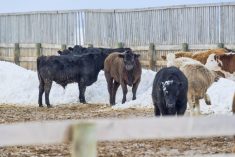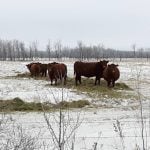Western Canadian feeder cattle prices stabilized over the past week, trading $5 to $8 higher in comparison to seven days earlier. In Manitoba and eastern Saskatchewan, calves traded up $10 to $15 higher largely due to a resumption in U.S. buying interest. The market was functioning to encourage demand, and with prices $25 to $30 below the August highs, feedlot operators felt more comfortable stepping forward.
Optimal weather and feature sales at most auction barns renewed optimism like a New Year’s Eve celebration. Dreams of last year’s margins were roaming the minds of all feedlot operators; they may be rolling the roulette wheel but there’s no chance to make money if you’re not at the party. If you can’t lock in a margin, you still have to be in the business, and empty pens are not an option. Only time will judge decisions, but this market is not for the faint of heart.
Read Also

U.S. grains: Soybean futures rise on active Chinese buying
Chicago | Reuters – U.S. soybean futures edged higher on Friday on increased Chinese demand for American supplies. Wheat and…
Alberta packers were on the sidelines because they have coverage until mid-November. However, strength in deferred live cattle futures provided some incentive to take on the risk with replacement cattle. The seasonal lows appear to be in place for the beef complex as restaurant and retail movement generally pick up in November for the holiday season. Wholesale beef prices showed signs of life, bouncing off the lows this past week; however, values are still sharply below year-ago levels.
Top-quality 500-lb. steers traded in the range of $300 to $310 in central Alberta, while in southern Manitoba, these cattle were actively moving from $310 to $318. Medium-frame mixed red steers averaging just over 600 lbs. were quoted at $275, landed in southern Alberta feedlot, while Winnipeg’s livestock market reported top-quality 600-lb. steers trading up to $293. The premium has come off feather-light calves under 400 lbs., with these animals now trading at values similar to the 500- to 600-lb. category. Heavier yearlings were quite variable across the Prairies, largely due to the uncertainty in the nearby fed cattle market. Feedlots are having a hard time moving the cattle in the feedlot and adding short-keep cattle to the mix adds to the nearby financial uncertainty.
— Jerry Klassen is manager of the Canadian office for Swiss-based grain trader GAP SA Grains and Produits. He is also president and founder of Resilient Capital, which specializes in proprietary commodity futures trading and commodity market analysis. Jerry owns farmland in Manitoba and Saskatchewan but grew up on a mixed farm/feedlot operation in southern Alberta, which keeps him close to the grassroots level of grain and cattle production. Jerry is a graduate of the University of Alberta. He can be reached at 204-504-8339.















